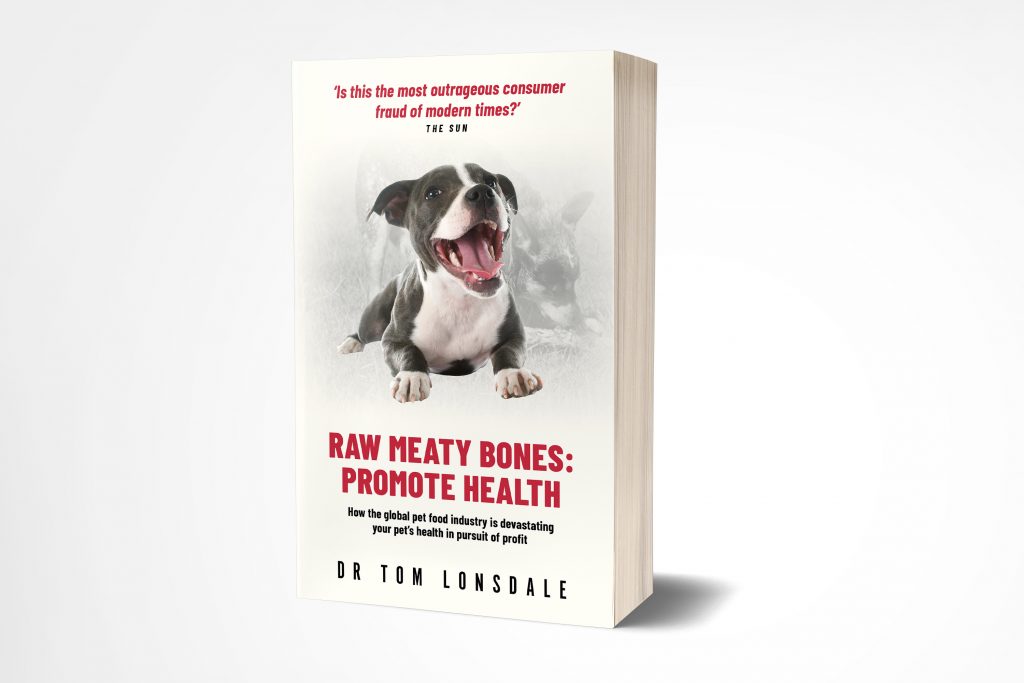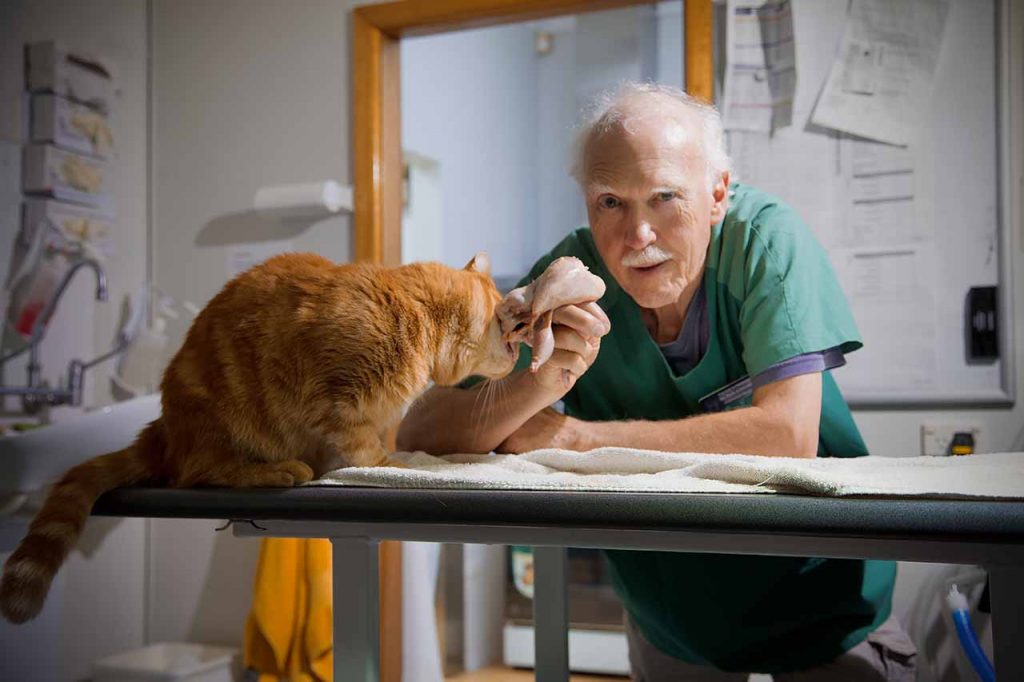An Interview with Dr. Tom Lonsdale by Literary Titan – Detailing “Raw Meaty Bones: Promote Health” and the story behind it. You can find Literary Titan’s 2024 review of the book here.
In Raw Meaty Bones: Promote Health, you examine the pet food industry’s impact on pet health and set forth best practices for a healthy diet and appropriate animal care. Why was this an important book for you to write?
A confluence of personality traits (scepticism, obduracy, and determination) coupled with life experience presented me with glittering multi-dimensional information. In the palm of my hand, I held what I believe to be the most important veterinary and animal care information to emerge in the 21st Century. It was both my good luck as a scientist and my inescapable obligation as a global citizen to communicate the information to a dependent public and their animals.
From my epiphany in the late 1980s, and following blowing the whistle on the junk pet food/veterinary alliance in 1991, I knew that the information was critical for the welfare of pet carnivores and worth billions of dollars to the human economy and natural environment. In December 1992, I published a short article “Raw meaty bones promote health” that showed how previously difficult to treat diseases resolved with dental treatment and the ‘miracle’ effects of a raw meaty bones diet. And in that same month, on Christmas morning in 1992, I woke with the fully formed Cybernetic Hypothesis of Periodontal Disease in Mammalian Carnivores, a hypothesis that I believe will one day revolutionise medical and veterinary science.
Back then, at 53 years of age, I understood that communicating the information could not be left to random chance. I had to ensure that the information was assembled between the covers of a book for the benefit of future generations. The book provides 13 chapters in support of Chapter 14, “The Cybernetic Hypothesis.” Along the way, vital information about the collusion of the vet profession with the mass pet poisoners in the junk pet food industry took centre stage. Reinterpretation of the immune system function and exciting aspects of apoptosis (programmed cell death) and biofilms (how bacteria live in nature) were in their infancy. To me, they were riveting aspects of a set of subjects mostly suppressed by the dead hand of the junk pet food/vet alliance.
A core aspect running as a theme throughout my research was the crucial need for carnivores to rip, tear, and gnaw at the meaty bones of other animals. It’s the key to the carnivore code and their reason for living. It’s their highly prized reward for the risks entailed in doing a good job in their role regulating prey numbers. ‘Like a dog with a bone’ domestic dogs, cats, and ferrets exhibit the same craving for the reward—raw meaty bones—as do their wild cousins.
Unfortunately for pets and their owners, a cult of Born Again Raw Feeders (BARF) emerged in the 1990s. The cult followers of their guru Ian Billinghurst traduced the fundamental raw meaty bones carnivore code. According to them, dogs are omnivores and a mush of pulverised meat, bone, and vegetables was all that was needed. Raw Meaty Bones: Promote Health was written with a view to countering the BARF nonsense and returning the focus to the pet food/vet multi-billion-dollar fraud.
I want the book to provide the foundation for successful billion-dollar legal actions against junk pet food companies, both cooked and raw, and the corrupt veterinary profession and thus enable a scientific renaissance benefitting pets, people, and the planet.
How much research did you undertake for this book, and how much time did it take to put it all together?
1991/2/3 were exciting years of dietary and periodontal disease (gum disease) discovery and writing. It was akin to visiting a new continent, a new planet even, and making exciting new findings around every corner. We, by whom I mean my veterinary colleagues and I, were conducting clinical research and I was burying myself in the gum disease and ‘nutrition’ literature. In the next few years up to 1997, we consolidated our findings in verifiable, repeatable theoretical and practical treatment and prevention options.
In 1997, I sold my veterinary practice to devote myself full-time to finding literature references and writing down the text. First, I had to learn to type and use a computer. I even acquired a custom-made chair to ensure the many hours to be spent at the computer would not be compromised. By the end of 1999, the first draft of the manuscript was completed. The year 2000 was spent finalising the manuscript with the help of two separate editors, seven lawyers, book designer, and typesetter.
In early 2001, printing contracts were signed and the book was all set to be published. However, the printing firm reneged on their contractual obligations due to possible retribution from the pet food/vet collaborators. It was a tense time fearing that calamity would befall the project. Fortunately, a new printing company was prepared to run the risks, and the first copies rolled off the press in August 2001.
What is a common misconception you feel people have about pet care?
Most people have a poor understanding of the biological needs of pets. They don’t think of them as modified wolves or feline desert predators with essential needs to rip, tear, and gnaw at the meaty bones of other animals. Pet owners, through relentless false and misleading propaganda, have been sold a package of bogus concepts: That pets are animated furry toys whose daily needs are met by the furry toy formula on the supermarket shelf and if things go wrong then the furry toy fixer (the vet) is on hand to assist.
Pet keeping was popularised in the 1860s courtesy of Jack Spratt and Charles Cruft who were intent on marketing their junk pet food biscuits. They developed pedigree dog shows to promote the keeping of dogs (modified wolves) as essential accoutrements to everyday life. Now after 150 years of false and misleading promotions, the community knows only what the junk pet food/vet collaborators tell them. And these days things are made worse by a plethora of book writers, bloggers, and sundry influencers who swamp the communication channels with their madcap raw recipes and formulas.
Power, prestige, and profit are the driving forces that ensure relentless misinformation rains down from every direction—and the animals suffer in silence.
What is one thing you hope readers can take away from Raw Meaty Bones: Promote Health?
I want readers to appreciate that the book contains vital interlocking pieces of information with significance on several levels. It identifies underlying fallacies, teases those fallacies apart, and recommends solutions of immense significance.
I want everyone to first stop and attempt to unlearn and reject the bogus concepts they’ve been force-fed this 150 years past. If, and I fully understand the difficulty, owners find unlearning difficult, then I hope readers will hold their previous beliefs in suspense and start over again. I want readers to understand that as The Canine Journal review stated:
“Just a quarter of the way into Dr Tom Lonsdale’s Raw Meaty Bones: Promote Health the thought crossed my mind that here was a Silent Spring [the book that kickstarted the environmental revolution] for companion dogs and cats. By the time I was halfway through I was in no doubt.”
I want everyone to read the book several times because as Alison Tyler wrote:
“As a five times reader of Dr. Tom Lonsdale’s book Raw Meaty Bones: Promote Health I find it useful to reflect on what each reading gained for me, particularly when assisted by Dr. Lonsdale’s suggested reading list.
My first reading of Raw Meaty Bones was shortly after publication. It was a literal read and produced a reaffirmation of beliefs I had long held regarding the collusion and corruption of the veterinary profession, working hand-in-hand with multinational corporations.
For several years I had followed Dr. Lonsdale’s work and writing. The book brought all into focus.
But there is a bigger picture contained in the book — though some aspects were elusive on the first reading. What seems on the surface to be a straightforward issue — multinational companies through propaganda and lies stealing from the world and harming animals with the willing assistance of the veterinary profession — is in fact the foundation, the building blocks, for issues and changes that stretch across professions, belief systems and disciplines.”
And whilst we’re waiting for the raw meaty bones revolution, I want individual pets to be rescued from the ravages of processed food, whether cooked or raw.



